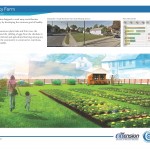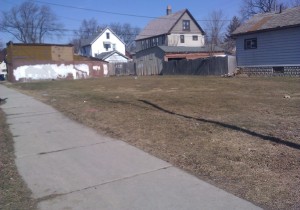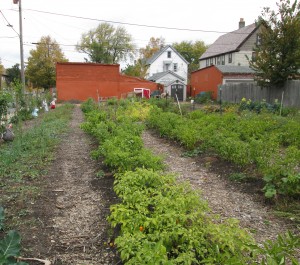There’s a good chance that anyone who’s lived on Milwaukee’s south side has heard of Pete’s Fruit Market. Lately, this neighborhood staple has been engaging in initiatives to provide nutritious foods and promote healthy lifestyles to the surrounding community. One of MIAD’s Service Learning students had a role to play in one of their most current projects – an urban farm down the block from the main store, with fruits, vegetables, chickens, and honeybees.
Service Learning is a course required of all MIAD students. It includes a mandatory community service component at a location of the student’s choice. When Adam Carter began the Service Learning course “Plant Yourself,” which focuses on sustainable food, during the Summer 2014 semester, he had a background in landscaping and was majoring in Industrial Design. As Adam looked over his options, he was informed of an opportunity being made available to MIAD service learners through CORE/El Centro, and it seemed like a perfect fit.
CORE/El Centro is a non-profit in Walker’s Point that provides natural therapies to the community on a sliding scale. It offers a Garden and Nutrition Program, run by Program Coordinator Stephanie Calloway, which aims to increase access to locally-grown produce and to develop the community’s knowledge and skills to make healthy eating choices. The program provides educational workshops at their on-site rooftop garden, cooking classes, and a Children’s Wellness program, among many others.
In 2012, CORE/El Centro, as part of the Southside EAT (Empowerment, Access, Transformation) Coalition – a group of organizations working to improve health through food – worked with Pete’s Fruit Market to implement a Healthy Grocery Store campaign. When Pete’s later showed interest in creating an urban farm near their store on the south side, CORE/El Centro was one of the first organizations recommended to them. The idea took root.
In Spring 2014 the project was initiated. After some discussion with MIAD, CORE decided it would be beneficial to take on a MIAD Service Learning student to assist with the design of the farm. Adam was one of the first students interested. He contacted Stephanie, and soon enough, the collaboration began.
- Adam’s final rendering of the community farm. Click to view larger.
Adam worked back and forth with Stephanie and another project participant, Cesar Cerna – a Mayan farmer with many years of experience with agriculture, who led the design, layout, and maintenance of the farm. Adam was able to keep in mind all of their ideas and from them, create a design rendering, plan view, and PDF presentation of the farm that CORE and Pete’s utilized in a presentation to their donors.
Stephanie explained, “When Adam joined the project we had a grass-covered vacant lot, a few organizational partners, and a great idea. He helped us to bring the great idea into a tangible vision that we could share with community members at our first Open House. This design was also leveraged to bring in some of the initial funds for the project.”
Left: The vacant lot on Muskego Avenue prior to construction. (Photo courtesy of Adam Carter)
Below: Pete’s Farm as of October 2014, complete with rows of peppers, tomatoes, ground cherries, and a chicken coop at the back.
Stephanie brought in volunteers from the Garden and Nutrition Program, supported volunteer coordination and community engagement, and along with Pete’s Fruit Market and the UW Cooperative Extension of Milwaukee County, aided weekly community activities, and larger seasonal events. In addition, there were several volunteers from within the neighborhood and outside of it, who were instrumental in bringing the project to life.
Pete’s Farm was actualized and open by June. It currently sells produce at two weekly markets and occasionally at Pete’s Fruit Market. Community members come out on Wednesdays to pick their own produce and help tend to the gardens. One volunteer, at the time a CORE staff member, was also hired by Pete’s to oversee the farm’s maintenance.
CORE has participated in the “transformation of a vacant lot into a community asset,” says Stephanie, which it can now draw on as another resource in the area for workshops and programs. They have plans for more ongoing programming come 2015.
MIAD Service Learning is proud to see the participation of one of its very own in this endeavor. Adam has gained hands-on experience bringing a functional project to completion, allowing him to exercise his professional skillset and to build connections in the community. He also intends to use the outcome of the project as a portfolio piece. Ultimately, however, he says, “…the best part was finding out that the deliverables I produced exceeded expectations. I really wanted to do something useful for CORE and to hear that I was successful in that was simply fantastic.”
At Pete’s Farm, members of the community can get their hands dirty, learn how to produce their own food, and practice a healthy way of life. The farm is a multipurpose resource, providing not only fresh produce, but also knowledge, a sense of community, and potentially, positive social change.
For more information about Pete’s Farm or the other people and organizations involved, check out these links!
Pete’s Farm: http://petesfruitmarket.com/the-market/community-farm/
CORE/El Centro: http://www.core-elcentro.org


